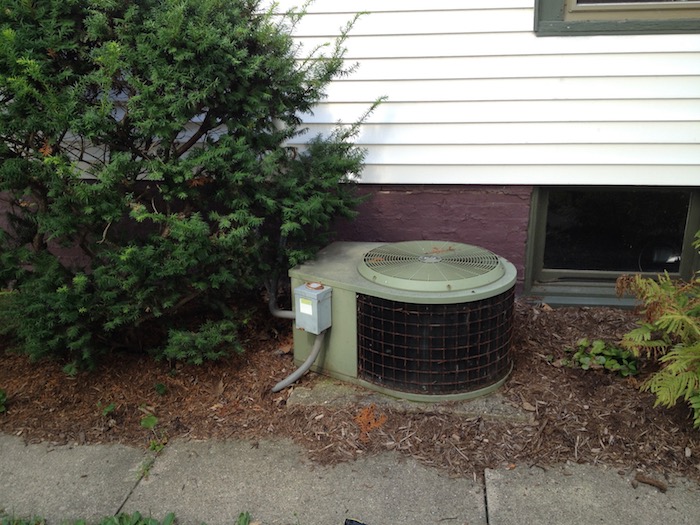This 4 part series shows some of the decisions and work done to economically upgrade a forced air furnace and ac system. The goal is to reduce the overall cost while improving the finished quality by taking on some of the smaller jobs as DIY instead of bundling the work with the HVAC contractor.
Replacing a furnace or an air conditioner is usually the sole realm of licensed contractors, but that one BIG job is composed of many little jobs. A lot of those little jobs are in the realm of an experienced DIYer.
To save some money on the replacement of our furnace and air conditioner, I did some of those little jobs myself.
Here is a picture of our old AC condenser.
The bush is overgrown and needs to be trimmed back. That doesn’t take any special skills or training. Also, the electrical disconnect box is mounted on the condenser itself which is against building codes. It should be mounted on the house. If you have done other electrical projects in the past that is certainly a project for an intrepid homeowner. Physically removing the condenser isn’t difficult once the old refrigerant has been removed. If you don’t know how to properly remove the refrigerant have a professional come and do it. With the old unit removed and the concrete pad exposed we can make further progress. This concrete base was too small so I tore it out as well. You might think that concrete would be hard to remove, but if you can get something under it like a 2×4 it will break up very easily.
With the old unit removed and the concrete pad exposed we can make further progress. This concrete base was too small so I tore it out as well. You might think that concrete would be hard to remove, but if you can get something under it like a 2×4 it will break up very easily.
I made a new concrete form and did some excavating.
A layer of gravel went in first and some bracing stakes went in around the perimeter.
 With Frugal Boys help, I mixed up a bag of concrete at a time in a wheelbarrow I found in the trash.
With Frugal Boys help, I mixed up a bag of concrete at a time in a wheelbarrow I found in the trash.
 Using a sacrificial 2×4 as a make shift screed, I leveled off the top of the concrete so it sat flush with the form.
Using a sacrificial 2×4 as a make shift screed, I leveled off the top of the concrete so it sat flush with the form.
 After it had set up a bit, Frugal Boy and Frugal Girl both left their marks. Make sure you wash off any concrete from skin as it can cause a nasty chemical burn if left on.
After it had set up a bit, Frugal Boy and Frugal Girl both left their marks. Make sure you wash off any concrete from skin as it can cause a nasty chemical burn if left on.
 While I could have reused the old electrical disconnect box, I bought a newer one and hooked it up.
While I could have reused the old electrical disconnect box, I bought a newer one and hooked it up.
It isn’t too terribly difficult, but there is a lack of instructions that come with the products.
To finish up the project, I added some hardscaping around the new pad. The idea is that
- It will keep down on vegetation growing too close.
- The service man will have a cleaner workspace. Instead of sitting in mud and tracking that into your house, they can keep clean.





